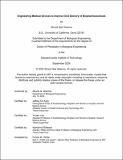Engineering Medical Devices to Improve Oral Delivery of Biopharmaceuticals
Author(s)
Sharma, Shonit Nair
DownloadThesis PDF (9.296Mb)
Advisor
Karp, Jeffrey M.
Lee, Yuhan
Ribbeck, Katharina
Terms of use
Metadata
Show full item recordAbstract
The dynamic mechanics of the gastrointestinal (GI) tract, including gut contractions, variable pH, and degradative enzymes, significantly challenge the development of oral delivery systems for biologic drugs by compromising their reliable delivery and therapeutic efficacy. While recent advances in oral delivery systems offer improved absorption through tissue penetration, their clinical translation remains tenuous due to the uncertainty of actuation-based delivery in variable environments and inherent design complexity. Inspired by the compression-based toxin delivery system of the stonefish, we developed a simple oral delivery device that harnesses GI mechanics to reliably actuate and systemically deliver biologic drugs. By synchronizing device actuation with gut contractions, the device and tissue work in tandem to ensure the complete transfer of a loaded therapeutic from the device to the tissue, bypassing physical and biochemical barriers and maximizing absorption. Through ex vivo and in silico experiments, we engineered the geometry of the device to achieve safe and targeted injections in the gut. An ex vivo electromechanical simulation model revealed the effectiveness of gut contractions for device actuation, and extensive in vivo experiments involving minipigs demonstrated comparable biologic drug delivery efficacy to subcutaneous injection. Harnessing the dynamic mechanics of the GI tract to improve oral delivery could transform drug administration and significantly enhance the lives of many patients.
Date issued
2024-09Department
Massachusetts Institute of Technology. Department of Biological EngineeringPublisher
Massachusetts Institute of Technology